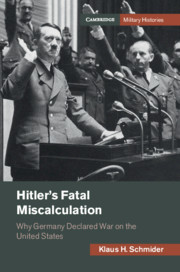Book contents
- Hitler’s Fatal Miscalculation
- Cambridge Military Histories
- Hitler’s Fatal Miscalculation
- Copyright page
- Epigraph
- Contents
- Figures
- Maps
- Preface
- Acknowledgements
- Abbreviations and German and Russian Terms
- Introduction
- 1 Hitler’s Pre-War Assessment of the United States and Japan
- 2 Hitler’s Physical Health in Autumn 1941
- 3 ‘All Measures Short of War’: the German Assessment of American Strategy, 1940–1941
- 4 Forging an Unlikely Alliance: Germany and Japan, 1933–1941
- 5 Facing the Same Dilemma: the US and German Quest for Rubber
- 6 The Crisis of the German War Economy, 1940–1941
- 7 The End of Blitzkrieg? Barbarossa and the Impact of Lend-Lease
- 8 The Battle of the Atlantic
- 9 The Luftwaffe on the Eve of Global War
- 10 The Holocaust
- Conclusion
- Bibliography
- Index
9 - The Luftwaffe on the Eve of Global War
Published online by Cambridge University Press: 08 January 2021
- Hitler’s Fatal Miscalculation
- Cambridge Military Histories
- Hitler’s Fatal Miscalculation
- Copyright page
- Epigraph
- Contents
- Figures
- Maps
- Preface
- Acknowledgements
- Abbreviations and German and Russian Terms
- Introduction
- 1 Hitler’s Pre-War Assessment of the United States and Japan
- 2 Hitler’s Physical Health in Autumn 1941
- 3 ‘All Measures Short of War’: the German Assessment of American Strategy, 1940–1941
- 4 Forging an Unlikely Alliance: Germany and Japan, 1933–1941
- 5 Facing the Same Dilemma: the US and German Quest for Rubber
- 6 The Crisis of the German War Economy, 1940–1941
- 7 The End of Blitzkrieg? Barbarossa and the Impact of Lend-Lease
- 8 The Battle of the Atlantic
- 9 The Luftwaffe on the Eve of Global War
- 10 The Holocaust
- Conclusion
- Bibliography
- Index
Summary
The declaration of war on the US found a Luftwaffe which was already stretched to the limit. 80 % of its units were supporting the war in Russia, with the remainder engaged in western Europe and N. Africa. In Germany the Flak arm (anti-aircraft units were part of the Luftwaffe) was engaged in checking the initial phase of Bomber Command’s war against German cities. Against such a backdrop, a further escalation of the war would appear to be a suicidal undertaking. This chapter will focus on how Hitler and Luftwaffe C-in-C Göring would have perceived the situation in November/December 1941. All available sources support the idea that Hitler had every reason to take an optimistic view of the future development of the air war. Three new promising aircraft designs were nearing readiness, recent victories in Russia led to the shift of a substantial number of units to the Mediterranean and Bomber Command’s campaign against German urban areas had been checked by the introduction of a gun-laying radar for the Flak arm. A series of unexpected events which occurred from late December 1941 would reveal these expectations to be false hopes, but this fact would have remained hidden from the German leadership in early December.
Keywords
- Type
- Chapter
- Information
- Hitler's Fatal MiscalculationWhy Germany Declared War on the United States, pp. 484 - 522Publisher: Cambridge University PressPrint publication year: 2021

